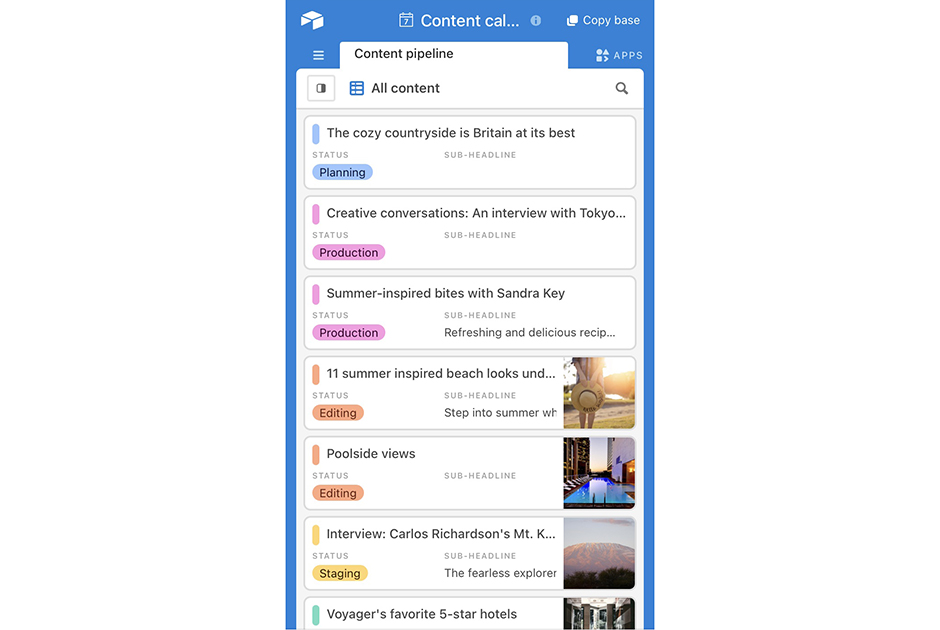Last month, I explained all the reasons why you should use a monthly calendar to plan and publish to social media. This month, I begin to outline a strategy and tips on how to do it.
Your social media calendar can be created on a daily, weekly, monthly or even yearly basis. The main goal is to work ahead. Don’t wait until the morning of the day you want to publish.
There are apps and services, free and paid, that offer templates and tools to help you get started. It will come as no surprise that most of the free tools are hosted by companies that also offer paid services. But by trying out some of the free versions, you get a feel for what the job requires, and learn which features are most helpful and worth paying a monthly fee to use.
You can find them by simply Googling “free social media content calendars,” but I’m listing a few below for reference. In some cases, you will have to give them your email address to get the free downloadable template.
You also can create one as a Google or Microsoft Excel spreadsheet. The Hootsuite template is created in Google sheets and provides a good example if you’d like to create your own. The advantage of having the spread sheet online is that multiple people can edit it so it’s a real-time document.
Each business will have different techniques or workflow that will impact what your content calendar tracks. The companies that offer paid services have tabs to enable you to switch back and forth to multiple screens documenting different things.
Paid calendar content services allow you to track more information. If you have a full team simultaneously working on social media, these will be highly beneficial. For one or two people just getting started, a spread sheet will work.
Here is a rundown of some of the basics you want to include. I recommend looking at the different types of free calendars online to help you decide what you want in yours.
You should have a column in which you will vertically list each platform or channel you want to include, for example, Facebook, Instagram, Twitter, etc. Next to that is a column for the date of the post and a separate column for the time. For channels where you might post three times a day—breakfast, lunch and dinner—the time will matter.
I highly recommend scheduling posts in advance, that will be another article, but another reason why you need to decide on a time.
The next column should be the content type. This might be a video, blog, promotion, curated (meaning you are sharing content from another source), or evergreen. Evergreen content is something that will always have a sustained level of interest. So anything seasonal, trends, news, etc., is not evergreen. Generally, it is tips or advice that never gets outdated.
Some examples of evergreen content would be:
“How To Choose The Best T-Shirt To Promote Your Business”
“Five Ways to Save Money on Your Next T-Shirt Order”
“How To Raise Money For Your School or Team”
The next column is the topic of your content. This also might be the headline. So using the examples listed above this might be: “Choosing T-Shirts,” “Five Ways to Save Money” or “School/Team Fundraising.”
The column next to topics is the actual copy. If it’s long, you might put the file name of the document the copy is on. If your post involves including a link, put the link in the next column, and finally have a column for notes.
Now that you’ve got a blank spread sheet, you can start filling in your calendar.
First, pick which channels you want to include. If you are just getting started, I recommend only choosing one channel. Establish a solid workflow for posting to that channel before tackling another one.
Within that channel, I recommend auditing your own page(s) if you have any, and I’d check out a few of your top competitors as well. Social media auditing is another article, but in a nutshell, you want to list what types of posts did well and which did not. Obviously, don’t keep posting topics that are being ignored.
I also suggest creating a folder to store social media assets. This will include photos, links to content you want to share, blogs, anything you will want to use for content. If the folder will be used by more than one person, it should be accessible to everyone.
Hand in hand with creating your calendar should be establishing a workflow. Set up a checklist of what needs to be done and who’s going to do it. Also set deadlines for assignments. This will be especially critical if one person, perhaps a copy writer, is waiting on another person, the photographer, to start his or her part of the process. Deadlines ensure scheduled posts are created in an orderly manner and get published on time.
If you want to tap into the power of social media marketing, the only way to give it a fair chance is to have regular, consistent content. You need engaging, informative posts on your page, whether or not you plan to boost your exposure with advertising. A social media content calendar is the best way to get this done in an efficient, quality manner.
Next month, I’ll go deeper into discussing what categories or buckets you want to establish for your business with ideas on how to fill them.
Deborah Sexton is the former editor of Impressions Magazine, where she worked from 1981 to 2001. She now owns her own company, Saracen Communications, doing digital media marketing, copywriting, and public relations for companies in the decorated apparel industry. You can reach her at [email protected].





